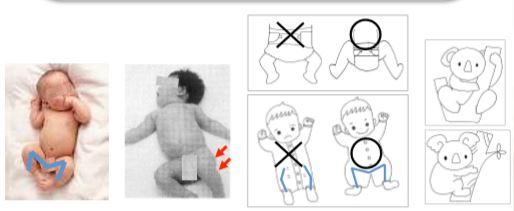14 Dec Beware of risk of a baby’s hip dislocation (dysplasia).
It is very important to take care of your baby properly.
Congenital dislocation of the hip, or developmental dysplasia of the hip (DDH) is a hip joint dislocation(股関節脱臼”kokansetsu-dakkyu”).
DDH occurs rarely in 1 to 3 baby per 1,000 births.
Careful handling of a baby will help prevent and reduce such occurences. If you observe in your baby more than one item listed below, please take care of him/her properly and don’t forget to have your baby examined at the 3rd or 4th-month health check-up.
Signs and symptoms to watch. : Your baby
- tends to have one-sided head position.
- is a girl. (DDH is more common in girls.)
- has a family history of people with hip problems.
- was breech. (in a bottom-first position before birth instead of a head-first position).
- was born in a cold region or in winter time (between November and March). Wrapping up a baby with clothes in a straight-leg position makes a baby more prone to DDH.
If your baby has a habit to look in one direction, the knee on the other side tends to be raised. This position serves as a trigger of hip dislocation.Your baby’s hips should be in a spread squat position or the M-position.Your baby’s hips prefer to be open and move actively. (#1)
It is said that raising a knee or bending a knee inwards (#2) makes the hip joint dislocation more severe. You should also avoid having your baby’s hips and legs in a straightened position.(#3)

Left to Right #1, #2, #3, #4
How to hold your baby: Let’s do “Koala hold” or make a chest-to-chest contact with your baby. In this way your baby is held just around your chest facing you with the legs bent up and out in the M-position. As this proper holding looks like a koala holding on to a tree branch, we call it Koala hold. (#4) Using a baby sling to hold a baby in a chest-to-chest contact can create an M-shape with both knees and hips is acceptable. (#5) On the contrary you have to be very careful when using a sling for cradle hold which can’t allow baby’s knees to bend up and out and has a risk of straightened legs. (#6)
If a baby always takes a one-sided head position: Please pay attention to the leg of opposite side which he/she always looks at. You should try to let that leg bend up and out. You should continue talking with your baby from the opposite side of where he/she is looking at. Raising and tilting of the head and body to the other side with bath towels or pillows are advocated. Let’s find the best way for each child.(#7)
Left to Right #5(2photoes), #6(a photo with illustration), #7(2photoes)
Hip joint examinations should be performed one-month and 3 to 4-month check-ups. When potential abnormalities are suspected, babies are referred to the orthopedics department. Should you have concerns we strongly suggest you visit the orthopedics department for guidance.
Japanese Pediatric Orthopaedic Association : Developmental Dysplasia of the Hip (in Japanese)
Advice from a nurse : Hip dysplasia is commonly used in the US.The hip is a “ball-and-socket” joint. In a normal hip, the ball at the upper end of the thighbone (femur) fits firmly into the socket, which is part of the large pelvis bone. In babies and children with developmental dysplasia (dislocation) of the hip (DDH), the hip joint has not formed normally. Before check-ups if you notice symptoms listed above, please inform your doctor promptly.
Reference:
Boston Children’s Hospital
http://www.childrenshospital.org/conditions-and-treatments/conditions/d/developmental-dysplasia-of-the-hip
Stanford Medical
https://www.stanfordchildrens.org/en/topic/default?id=developmental-dysplasia-of-the-hip-ddh-90-P02755
https://hipdysplasia.org/developmental-dysplasia-of-the-hip/infant-signs-and-symptoms/
Written by D.S.L.BSW,BSN,RN,CCR
Also, please refer to our article “Soft chairs (We do not recommend the use of soft chairs.)


